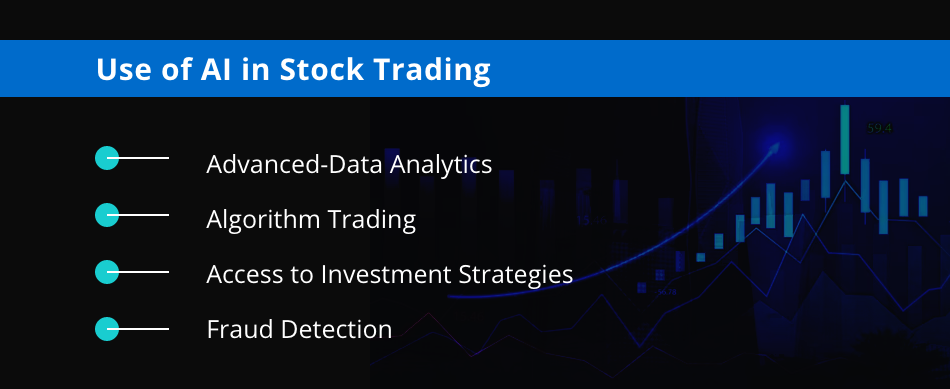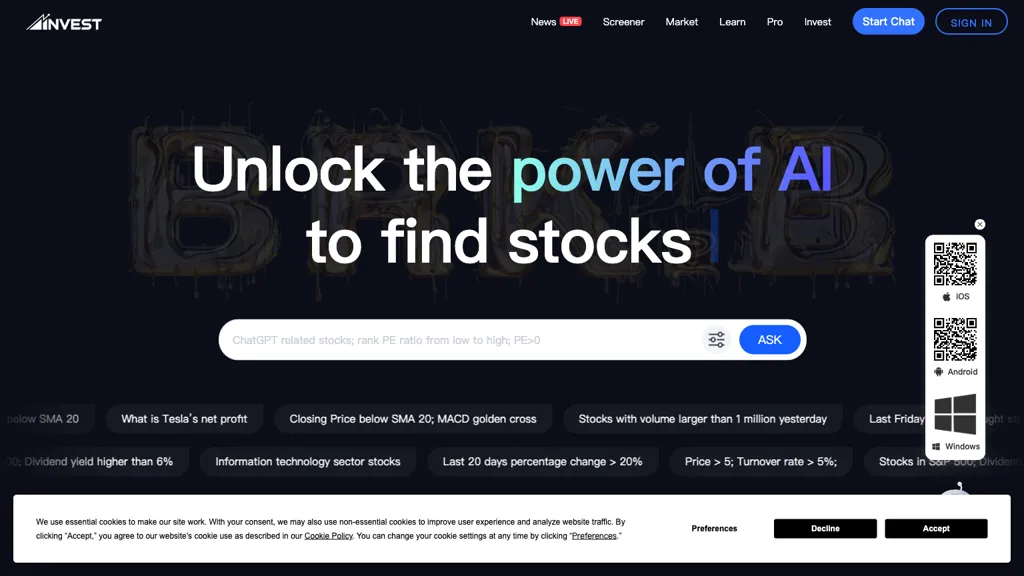Top 10 Tips For Evaluating The Accuracy Of Ai Stock Predicting Trading Platforms
In order to be sure that the tool you choose will provide accurate insights and forecasts, it’s crucial to assess its performance and accuracy. Here are the top 10 tips to assess these platforms efficiently:
1. Backtesting Results
What to look for: Ensure that the platform you choose to use allows you to perform back-testing to determine how accurate its predictions were basing their predictions on previous data.
Why It Matters : Backtesting can be used to verify the validity of an AI model through comparing the predictions with historical results.
Tips: Search for platforms that allow you to modify the parameters of backtesting (e.g., time periods, asset classes).
2. Real-time Performance Monitoring
What to Look For Check how the platform performs under real-time market conditions.
What’s the point? Real-time performance is a better gauge of the effectiveness of the platform than historical backtesting alone.
TIP: Sign up for a free demo or trial account to see how you compare the market’s real-time predictions with actual movements.
3. Prediction Error Metrics
What to Look for Utilize metrics like Mean Absolute Error, Root Mean Squared Error or R-squared to gauge the accuracy of your predictions.
What is the significance of these metrics provide a quantitative measure of how close the predictions are to the actual results.
Tip: Platforms that openly provide these metrics are typically more transparent and trustworthy.
4. The rate of winning and the success ratio
What to Look Out For Find out the platform’s winning percentage (percentage based on correct predictions) and also its success rate.
Why is it important What is important: A high win percentage and success rate suggests better predictive accuracy as well as the potential for profitability.
TIP: Beware of sites that advertise unrealistic win rates (e.g. 90, 90 %+), since there is no perfect system.
5. Benchmarking against market Indicators
What to Watch for: Compare performance and forecasts of the platform with important market indices.
Why it is Important It can be used to determine if a platform outperforming or is underperforming the general market.
Be sure to look for consistency in your performance, not only gains over a short period of time.
6. Consistency in Market Conditions
What to look for: Assess how the platform performs in different market conditions (bull markets, bear markets, high volatility).
What is important The platform that is robust must perform well in all market conditions and not only when the market is favorable.
TIP: Test the platform’s predictions during volatile periods or market declines.
7. Transparency in Methodology
What to look for What to look for: Learn AI models and algorithms (e.g. reinforcement learning and neural networks).
Why It Matters Transparency in methodology lets to assess the credibility and scientific rigor of the platform.
Beware of platforms that use “black box models” which don’t provide a clear explanation of how predictions can be generated.
8. Users Review and Independent Testing
What to Look for: Read customer reviews and independent tests, or third-party reviews.
Why is it Important The independent testing and reviews provide unbiased insight into the reliability of the platform.
Read user reviews on forums such as Reddit copyright and financial blogs.
9. Risk-Adjusted Returns
What to Look for What to look for: Evaluate the platform’s performance by using risk-adjusted metrics such as the Sharpe Ratio and Sortino Ratio.
Why It Matters What is important? on the level at which risk is taken to produce returns. This gives a more complete image of performance.
Sharpe Ratios above 1 indicate better returns, adjusted for risk.
10. Long-term Track Record
What to look for: Assess the platform’s performance over a longer period (e.g., 3-5 years).
Why It Matters: Long-term results are a better measure of reliability than results from the short-term.
Tip: Avoid platforms that focus on short-term success or cherry-picked results.
Bonus Tip Test with an account demo
You can try out predictions on the platform in real-time without risking any real money by using a free trial account or demo account. This lets you evaluate accuracy and performance.
Following these tips can help you assess the accuracy and performance of AI platform for predicting stocks. This will help you to select a platform that best suits your trading needs and risk tolerance. Be aware that no platform can be trusted, so using AI insights with your own research to the predictions of the platform is generally the best choice. Follow the most popular incite advice for more examples including using ai to trade stocks, AI stock trading app, AI stock trading bot free, best AI stock trading bot free, ai investing, trading ai, ai investment app, AI stock trading app, ai investment app, ai investing app and more.
Top 10 Tips On Risk Management Of Ai Trading Platforms That Predict/Analyze Stock Prices
Any AI trading platform that predicts or analyzes stocks has to include risk management which is vital for protecting your investment and limiting losses. Platforms that have robust risk management capabilities can help you navigate turbulent stock markets and make an decisions based on information. Below are the top 10 tips for assessing the risks management capabilities of these platforms:
1. Check out Stop-Loss and Take Profit features
Customizable levels – Make sure that the platform allows you to adjust your stop-loss, take profit and profit level for each strategy or trade.
Make sure that your platform supports trailing stops, which adjusts automatically in the event that the market moves toward your.
Stop-loss guarantee: Check to whether the platform offers stop-loss guarantees, which will assure that your trade will be closed at a specified price, even in volatile markets.
2. Measure Positions Tools
Fixed amount: Check that the platform you are using allows you to adjust the size of your position in accordance with a set amount.
Percentage of portfolio: Check whether you can establish position sizes as a percentage of your overall portfolio to control risk in a proportional manner.
Risk-reward-ratio: Verify whether the platform lets users define their own risk/reward ratios.
3. Check for Diversification Assistance
Multi-asset trading. Make sure your platform can handle different asset classes like ETFs as well as Forex, Options and stocks.
Sector allocation Check to find out what tools are available for managing and monitoring exposure to the sector.
Diversification of geographic areas. Verify whether the platform can trade internationally and spread geographic risk.
4. Evaluation of Margin and Leverage controls
Margin requirements: Ensure the platform is clear about margin requirements when trading leveraged.
Check to see whether you can establish leverage limits in order to limit risk exposure.
Margin calls: Ensure that you receive timely notifications from the platform in order to avoid account liquidation.
5. Assessment of Risk Analytics and Reporting
Risk metrics: Be sure the platform has important risk indicators to your portfolio (e.g. Value at Risk (VaR) Sharpe ratio, and drawdown).
Scenario analysis: Find out if the platform allows you to simulate different scenarios of market to determine possible risks.
Performance reports – Verify that the platform has specific performance reports, including the risk-adjusted returns.
6. Check for Real-Time Risk Monitoring
Portfolio monitoring: Make sure the platform allows you to monitor your portfolio in real time.
Notifications and alerts. Verify whether the platform provides real-time notifications of risk-related events.
Check the dashboards for risk. If you’re looking to see a complete picture of your risks, make sure they’re customizable.
7. Test Stress Testing and Backtesting
Stress testing: Ensure that the platform lets you stress test your portfolio or strategies under extreme market conditions.
Backtesting Check if platform supports backtesting using historical data to evaluate the risk and performance.
Monte Carlo simulators: Verify that the platform is using Monte Carlo to simulate a number of possible outcomes in order for you to evaluate the risk.
8. Risk Management Regulations: Assess your compliance
Regulation compliance: Ensure that the platform complies with relevant risk management regulations (e.g., MiFID II in Europe, Reg T in the U.S.).
Best execution: Make sure that the platform follows the highest standards of execution, and ensures that trades are executed at the highest possible price, minimizing slippage.
Transparency. Make sure the platform is transparent and clear about the risks.
9. Examine the User-Controlled Risk Parameters
Custom risk rules: Make sure the platform you select allows you to create custom risk management rules.
Automated risk controls: Determine if the platform can automatically enforce risk management rules in accordance with your predefined criteria.
Manual overrides: Verify that the platform supports manual overrides during emergency situations.
Review user feedback and case studies
User reviews: Examine user feedback to determine the effectiveness of the platform in managing risk.
Case studies Look up case studies or testimonials, that prove the platform’s capability to manage risks.
Community forums: Find out whether the platform has an active user community in which traders share risk management tips and strategies.
Bonus Tips
Trial period: Take advantage of an unpaid trial or demo to try out the features of the platform for risk management in real-world situations.
Support for customers – Ensure that the platform offers a robust assistance for any questions or issues relating to risk.
Look for educational sources.
If you follow these guidelines, you can determine the capabilities of an AI stock prediction/analyzing trading platform to manage risk. This will ensure you select a system that protects your capital, and minimizes any potential losses. Robust risk management tools are essential for navigating volatile markets and achieving long-term trading success. View the top he said about ai copyright signals for more examples including ai copyright signals, investing with ai, AI stock analysis, ai in stock market, ai investment tools, best ai trading platform, ai share trading, best AI stocks, best AI stock prediction, ai for trading stocks and more.